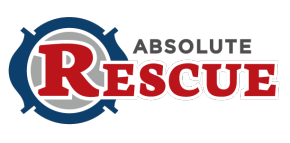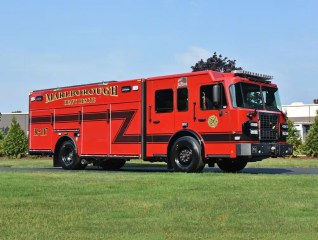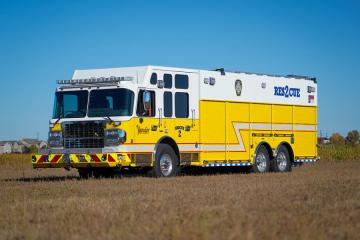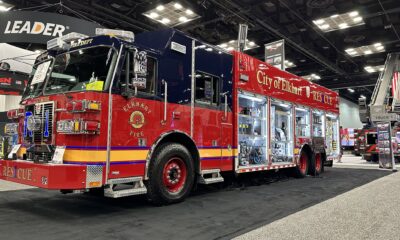There are many reasons a victim is trapped at mid height: gear malfunctions or failures, injuries resulting from falling debris, medical emergencies, etc. The first series of variables is what is supporting the victim’s load. There are two basic variables.
First, the victim is rigged or supported by a dynamic system (meaning it can move). This can simply be a rope or ropes as in the case of a climber, person rappelling, or a would-be rescuer.
It also can be an industrial application such as window washers or maintenance personnel on a cable-and-winch system or a ladder-based climbing system. In all of these examples, the assumption is that the system supporting these victims is under tension and carrying their load.
Second, the victim is supported by something static (meaning it is a fixed object or support system). This can simply be a ledge or window opening. It also can be a working platform upon which he may be safety rigged but do not have tension on his personal rigging.
In these examples, the assumption is that these victims are captured through gravity but are somewhat free to move minimally and their position at height is not under loaded tension.
First Steps
As we approach these scenarios we must assess the condition of the victim and the cause of the predicament. As we gather information regarding the cause, we will learn whether or not we can use the existing system or develop a new one.
This can radically shape the action plan.
If the victim is suspended by a cable-and-winch system that is safety compliant and intact and the victim is having a medical emergency, then using the existing system (provided rescuers can operate it) may provide the most effective solution.
However, if the victim was rappelling and suffered a gear failure, we will have to develop a complete high-angle system to accomplish the rescue.
If the victim is suspended on a loaded or tension system, we will have to bring gear that will allow us to transfer the victim from his system onto the rescue system.
As we refine our action plan and draw conclusions from these assessments, there is one final challenge to consider. What is the best approach for access and rescue.
Reaching the Victim
In these events, we may have crews above the victim, at the victim, and or below the victim. All of these options will shape the systems we select and how we deploy them.
A victim who is on a ledge in a cave, ravine or gorge will most likely require a hauling system to bring the victim up. This will require a lower haul system with a high directional.
It may also require bottom side crews to develop a tensioning track line or tensioned track line depending on the placement and height of the directional as well as the terrain features.
A victim who is trapped on the side of a water tower or hydropillar may only require topside anchoring and a rescuer who descends to the victim, packages, and then descends to ground.
A victim trapped at height that can be directly or proximally reached through a nearby window or platform may only require top-side safety systems to be rigged so the victim can be safely moved from the compromised position to an accessible position. The recent FDNY rescue was a good example of this application.
As always, the objective is to make the right choices to achieve the most optimal outcome for the victim and the rescuers. Do not over-rescue. With that said, here are the tangible points of rigging to perform a pick off of a stranded mid-height victim.
Load Transfer
This is when the victim is suspended on loaded rope or cable. Establish a belay line and moving brake line. Some organizations may elect to establish a fixed brake line in which the rescuer is lowered, but I have found that this application requires very finite communications and often results in miscues between the rescuer and the lowering team.
Conversely, the moving brake requires an experienced rescuer who is adept at rappelling and rigging. This should be the case, though, because pick offs are a level II skill.
Pre-rig the belay line for victim attachment. Put a knot, typically a figure eight on a bite, into the end of the belay line and attach it to the accessory loop on the rescuers harness with a screw link. This knot will be attached to the victim when the rescuer gains access to him.
I prefer the link to a carabineer because it can easily get side loaded during the pick off process and insures a higher safety factor. I avoid tying a knot into the victim’s harness because it can be time consuming compared with attaching a link or similar connecting hardware.
Once the knot is established, measure approximately one arm’s length and tie a midline knot; butterfly is acceptable here. This midline knot is the attachment point for the rescuer.
Pick-off Straps
Rig in a pick-off strap or self-minding short-haul system. Attach this element to the eye of the rescuer’s brake bar rack or other descent control device. It is important that this device eventually carry the load of the victim directly to the main line and not to the rescuer.
Pick-off straps have a U and a V attachment. The U goes to the rescuer’s rack or lowering line knot and the V gets attached to the victim. It is a good practice to make these attachments with screw links for the reasons previously mentioned.
Self-minding short-haul systems are typically 4-1 or 5-1 ratio systems with capturing cams or progress capture devices that self set. These systems will provide the rescuer with an added capability to haul the victim up a short distance.
Some of these systems come in small packs and can be carried down by the rescuer and deployed when needed. Pre-attaching will help speed up the rescue and may reduce potential rigging errors.
At the Victim
Rappel or descend down to the victim. Stop descending and lock off when the rescuers hips are at the same height as the victim’s head. This positioning is crucial to ensure that the transferring devices have appropriate spacing to be reached and operated.
Attach the belay line to the victim and the pick-off strap or short-haul system. I find that inverting at this point can greatly increase the efficiency of the rescuer. Inverting allows the rescuer to maximize her reach and use both hands.
Haul the victim up or pull tension on the pick-off strap until the load has transferred from the victim’s line to the implement you have applied. When using a pick-off strap, the load usually cannot fully transfer because not enough force can be generated by simply pulling the strap.
This requires the victim’s loaded descent-control device to be operated in a controlled manner until slack is developed. This is where short-haul systems will pay dividends. When the transfer is complete, disconnect any remaining unnecessary victim lines to reduce entanglements.
The victim should be oriented just below the rescuer and the pick-off strap or the short-haul system should be between the rescuers legs. If working on a wall, coach the victim to keep his arms crossed around his rigging so that he doesn’t grab the rescuer’s legs.
When the rescuer’s legs are grabbed, they lose foot contact with the wall both parties end up riding the wall. If not working on a wall, rescuers may direct the victim to grab their extended legs to prevent rotating or spinning independently of one another.
When preparing to descend or rappel to the ground, remember that an extra load has been picked up and the previous level of friction on the descent-control device will not be appropriate.
No Load Transfer
When the victim is static and not attached to tensioned lines, all of the steps are the same with the exception of transferring lines. This means we simply access the victim, attach the belay and pick-off strap, pull out slack and ease off the static platform.
This is a much more simplistic pick off, but often requires more packaging. These victims often do not have harnesses and require rescuers to put one on them. These victims also may be significantly injured.
This will require basket packaging and a lowering system on the top side with the rescuer transition to a tender. We will save that for another column.
Pick offs require a lot of repetition and are a high-risk rigging event. Watch the video to help drive the material home and then get out there and do it.
Remember you can statically go through the rigging progressions out in the bay so rep it out and be ready. Train hard.

This content provided in partnership with FireRescue1.com
High Angle Rescue
High-Angle Rescue Tactics: Keeping Victims Off Walls [w/Video]
Protrusions on cliffs or walls during high-angle rescues pose a threat to rescuer and victim; here are some simple ways to work around those obstacles.
One of the challenges rescuers may face when performing high-angle rescues involves controlling the position of the victim in more directions than simply up and down.
Any environment that presents a cliff or wall face with obstacles or outcroppings will require multidimensional control. This leaves rescuers with three basic choices: tending, tensioning tag lines or tensioning track lines. Be sure to watch the demonstration video at the end of this article.
Tending is when a rescuer progresses up or down with the victim and physically controls their position. This is the simplest rigging solution and usually requires only Level I skills.
There are many different ways to rig for this; the most common involves attaching a pick-off strap or small system such as a CMC Aztec between the master attachment point and the rescuer.
Belay attachments have many different configurations as well, but usually involve a midline knot attached to the master attachment point and the tail of the belay attached to the victim in the stokes basket or packaging device. Rescuers extend or collapse their system or pick-off strap to position themselves on the basket so that they can maintain foot contact on the wall or cliff face and use good body mechanics to pull out on the victim and work around obstacles.
Tensioning tag lines
Tensioning tag lines involves attaching rope(s) to the master attachment point or to the ends of the packaging device and pulling tension or giving slack to pull the victim away from the wall or allow them to get closer to the wall.
These ropes can be managed manually without a progress-capture or safety device in place, but the risk increases dramatically. If these ropes are not run through a safety device or paired prussiks to capture progress, the victim could careen dangerously into the wall or cliff face.
This is an additional challenge because a device needs to be selected that seamlessly transitions between hauling and lowering applications to manage the victim position. Traditional rigging such as an RPH would not be practical because of the time delays in transferring the load between operational modes.
The greatest danger with tensioning tag lines is the potential to overload the entire system. Tensioning tag lines result in oppositional forces to the top-side hauling system and multiplication forces during lowering operations. The lower/haul operation and the tensioning tag line operation have to be very closely coordinated to avoid system overloading.
Tensioning track lines
Tensioning track lines involves building a standard lower haul system and then building track line(s) with variable tension control. We then attach a pulley to the master attachment point, which is placed on the track line(s).
When track lines are used in this application, they are commonly referred to as guiding lines. Without delving into all of the advanced physics, there are some basic approaches that will keep you safe.
Use twin track lines. This is not always a necessity depending on load and angle or amount of tension applied to the track lines. However, a single track line does not afford any redundancy and can be easily overloaded when approaching critical angles.
In this application, alter the tension on the track lines as needed. This means the track lines will tension and slack as needed to pull the load away from the wall or cliff face but maintain as little tension as possible throughout the operation.
This approach greatly reduces much of the overload factor of track lines at critical angles, but using twins will always keep you safer.
High-strength tie offs
Apply high-strength tie offs or tensionless wraps to one end of the track lines and a 2-to-1 system in a series on the other end with a versatile progress-capture device such as a CMC MPD. Which end of the track lines serves what purpose is highly dependent on the environment and the choice of high directional at the top side.
There are other mechanical-advantage systems that can be used, but attaching two 2-to-1 systems that are in a series to each of the track lines will give the haul team adequate mechanical advantage to tension the track lines when needed but avoid having excessive mechanical advantage at their disposal, which could possibly overload the track lines.
I advocate the MPD because of its versatility for transitioning between tension and slack operations as well as the smooth cam, which provides good capture without the sheath penetration of a toothed-cam device.
Other devices can be used in this application provided they have appropriate design load and operational transitions that are seamless and simple. Attaching the 2-to-1 in a series system to the track lines is another option.
I encourage rescuers to apply 9-mm prussiks to their ½-inch rope to increase the strength and slip factor of the prussiks. The track lines cannot be anchored effectively because the track lines are moving constantly in this application so the increased safety of upgrading prussik diameter may pay dividends.
Tension when necessary
If an out cropping is present towards the top side, a margin of tension on the track lines may be required throughout the lift to avoid friction contact between the lower haul lines and the outcropping.
The other option is to place positional edge protection at the outcropping and then only apply tension when the load or victim package needs to clear the obstacle.
Both are viable options, but keep the load and ropes as close to the wall or cliff face as possible. This provides two margins of increased safety.
If the track lines were to fail, the impact of the load against the cliff face or wall will be greatly reduced by minimizing the distance of the pendulum arc. The second safety benefit is the reduction of force on the track lines. Keeping the tension at a minimum will help ensure safe forces on the track lines and eliminate overloading or critical angles.
To bring it all together, a good rescue team will have all of these approaches in their arsenal. Knowing the pros and cons of each application will help you make the right decision.
Remember to let the victim drive the rescue as well as the safety of your team. Train hard and continue to hone your knowledge, skills and abilities.


















